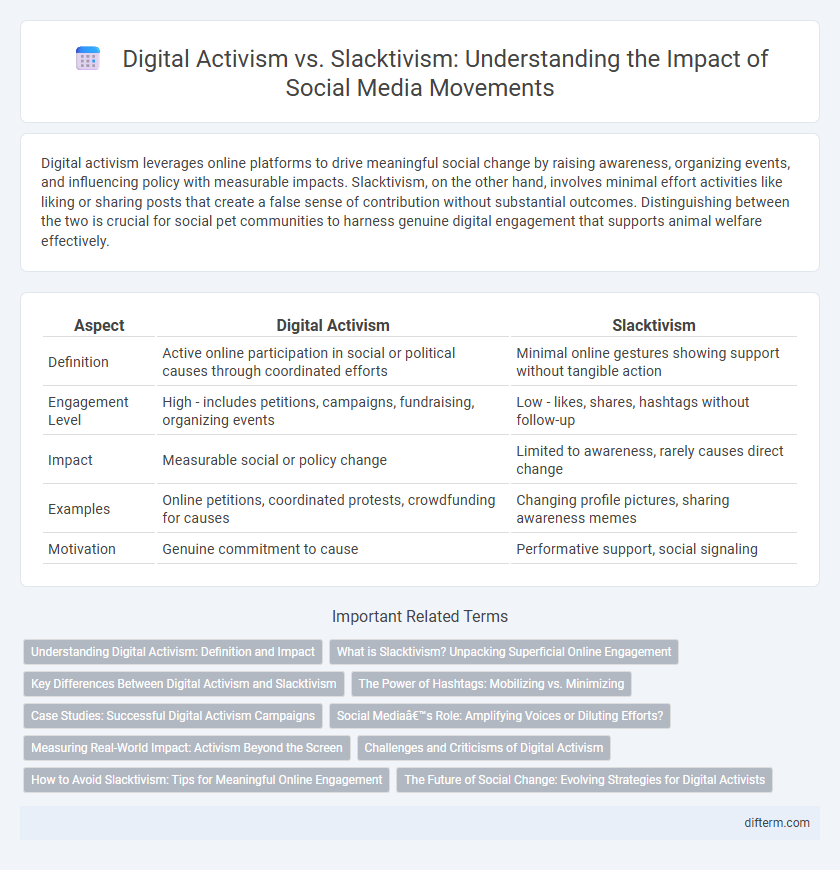Digital activism leverages online platforms to drive meaningful social change by raising awareness, organizing events, and influencing policy with measurable impacts. Slacktivism, on the other hand, involves minimal effort activities like liking or sharing posts that create a false sense of contribution without substantial outcomes. Distinguishing between the two is crucial for social pet communities to harness genuine digital engagement that supports animal welfare effectively.
Table of Comparison
| Aspect | Digital Activism | Slacktivism |
|---|---|---|
| Definition | Active online participation in social or political causes through coordinated efforts | Minimal online gestures showing support without tangible action |
| Engagement Level | High - includes petitions, campaigns, fundraising, organizing events | Low - likes, shares, hashtags without follow-up |
| Impact | Measurable social or policy change | Limited to awareness, rarely causes direct change |
| Examples | Online petitions, coordinated protests, crowdfunding for causes | Changing profile pictures, sharing awareness memes |
| Motivation | Genuine commitment to cause | Performative support, social signaling |
Understanding Digital Activism: Definition and Impact
Digital activism harnesses online platforms to mobilize social and political change, enabling widespread participation beyond traditional boundaries. Unlike slacktivism, which involves minimal online engagement such as liking or sharing posts, digital activism entails meaningful actions like organizing campaigns, petitions, and real-time advocacy. This form of activism amplifies marginalized voices, accelerates information dissemination, and can lead to tangible policy reforms and societal impact.
What is Slacktivism? Unpacking Superficial Online Engagement
Slacktivism refers to minimal online participation in social causes, such as liking or sharing posts, which creates an illusion of meaningful activism without driving tangible change. This superficial engagement often lacks commitment, reducing complex issues to momentary digital gestures instead of sustained action. Understanding slacktivism highlights the challenge of transforming online awareness into real-world social impact.
Key Differences Between Digital Activism and Slacktivism
Digital activism involves active participation in campaigns through online petitions, social media mobilization, and organizing virtual protests aimed at creating tangible social change, whereas slacktivism primarily consists of low-effort online activities such as liking, sharing, or commenting without substantial commitment or offline follow-up. The key differences lie in the impact and engagement levels: digital activism drives measurable outcomes and sustained involvement, while slacktivism often results in minimal real-world influence despite high visibility. Effective digital activism leverages technology to amplify voices and coordinate collective action beyond superficial online gestures associated with slacktivism.
The Power of Hashtags: Mobilizing vs. Minimizing
Hashtags serve as powerful tools in digital activism by rapidly mobilizing global communities around social justice issues, increasing visibility and driving offline actions such as protests and policy changes. However, in cases of slacktivism, hashtags often create superficial engagement where users merely show symbolic support without meaningful involvement or sustained advocacy. The effectiveness of a hashtag campaign depends on its ability to convert online awareness into concrete social impact rather than just generating ephemeral digital trends.
Case Studies: Successful Digital Activism Campaigns
The #BlackLivesMatter movement exemplifies successful digital activism by leveraging social media to mobilize millions worldwide, influencing policy changes and raising global awareness of racial injustice. Another vital case is the Arab Spring, where digital platforms facilitated real-time communication and coordination, leading to significant political uprisings across multiple countries. These campaigns demonstrate that strategic digital activism can transcend slacktivism by driving tangible social and political impact.
Social Media’s Role: Amplifying Voices or Diluting Efforts?
Social media serves as a double-edged sword in digital activism, amplifying marginalized voices and facilitating rapid mobilization around social causes while also risking slacktivism, where low-effort online actions substitute meaningful engagement. Platforms like Twitter and Instagram enable hashtag campaigns such as #BlackLivesMatter and #ClimateStrike to reach global audiences, but algorithm-driven content can dilute impactful messages by prioritizing virality over substance. Understanding this dynamic is essential for maximizing social media's potential to drive tangible social change without falling into performative activism traps.
Measuring Real-World Impact: Activism Beyond the Screen
Measuring real-world impact in digital activism requires analyzing concrete outcomes such as policy changes, community engagement, and offline mobilizations rather than mere online metrics like likes and shares. Effective digital campaigns translate online support into tangible actions such as protests, donations, or legislative influence, distinguishing them from slacktivism characterized by low-effort, symbolic gestures with limited societal effect. Data-driven approaches incorporating sentiment analysis, geo-tagged participation, and longitudinal studies offer comprehensive insights into the genuine efficacy of social media-driven movements.
Challenges and Criticisms of Digital Activism
Digital activism faces significant challenges such as online misinformation, digital surveillance, and the risk of slacktivism, where individuals engage in low-effort actions without creating substantial offline impact. Critics argue that digital platforms often prioritize performative support over genuine community organizing, leading to fragmented movements and short-lived attention spans. Despite these issues, the scalability and accessibility of digital activism continue to shape modern social advocacy and political engagement.
How to Avoid Slacktivism: Tips for Meaningful Online Engagement
To avoid slacktivism, prioritize actions that create tangible impact such as signing petitions from reputable organizations, donating to verified causes, or volunteering time for community projects connected to online campaigns. Engage critically by verifying information sources and encouraging offline discussions to amplify awareness beyond social media. Consistently track the effectiveness of digital activism efforts through measurable outcomes like policy changes or increased local participation.
The Future of Social Change: Evolving Strategies for Digital Activists
Digital activism is rapidly evolving with tools that enable deeper engagement beyond basic awareness-shifting, contrasting with slacktivism's passive online gestures. Future social change strategies emphasize leveraging data analytics, immersive technologies, and decentralized platforms to mobilize communities around actionable goals. Digital activists increasingly focus on measurable impact and sustained participation to drive systemic change in the social and political landscape.
digital activism vs slacktivism Infographic

 difterm.com
difterm.com